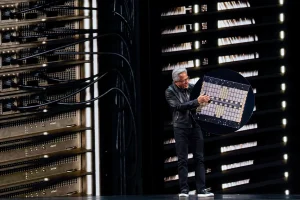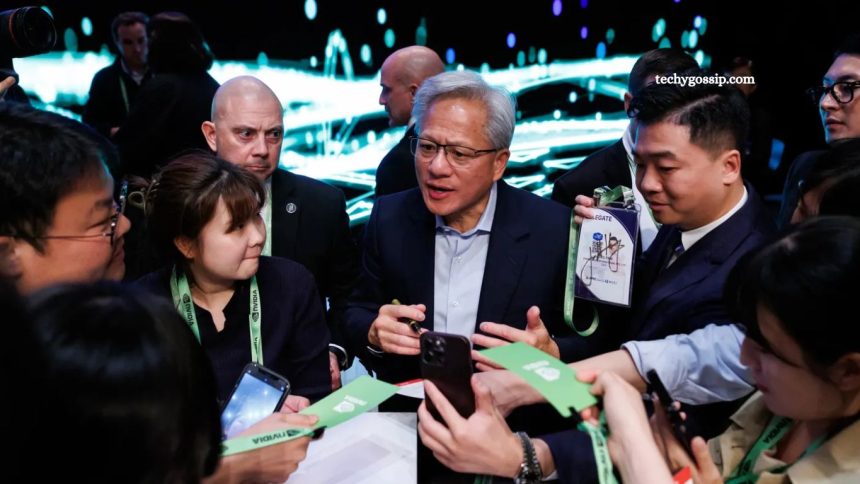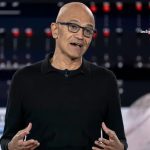Even for Nvidia CEO Jensen Huang, last week was extraordinary. The 62-year-old executive kicked off the company’s first developers conference in Washington, D.C., and wrapped up in South Korea with a dinner of fried chicken and beer alongside Samsung Electronics Co. and Hyundai Motor Group leaders. In between, Huang finalized multiple high-profile deals with companies including Nokia Oyj, Uber Technologies Inc., and Eli Lilly & Co.
In just five days, Nvidia’s market capitalization soared by nearly $400 billion, surpassing Toyota Motor Corp. and Home Depot Inc., as the company edges closer to becoming the first $5 trillion firm in history. Huang himself added over $9 billion to his net worth, bringing it to $176 billion, according to the Bloomberg Billionaires Index.
At the heart of this surge is Huang’s vision to accelerate global AI adoption and embed Nvidia’s technology across industries. The CEO is addressing skeptics who warn of an AI bubble by demonstrating that massive infrastructure investments—particularly in Nvidia’s chips—can deliver real returns.
“Nvidia is putting their money where its mouth is,” said JoAnne Feeney, portfolio manager at Advisors Capital Management. “They are showing specific examples of AI in action and the value being monetized.”
Read More: Microsoft to Expand Hiring, Boosting Efficiency with AI, Says CEO Satya Nadella
Expanding Nvidia’s Industry Reach
Nvidia’s recent partnerships extend its AI chips and software into sectors beyond tech giants like Microsoft and Meta Platforms Inc., which together account for roughly half of its revenue. This diversification helps reduce reliance on hyperscalers while connecting AI technology to telecommunications, transportation, healthcare, and even emerging fields like quantum computing.
With a strong cash position, Nvidia is well-equipped to fund these initiatives. “All those companies have high cash flow to support these activities,” said Margie Patel, senior portfolio manager at Allspring Global Investments. “They show no sign of slowing down in investing to maintain a leading edge.”
By positioning its products in self-driving vehicles, pharmaceutical labs, mobile networks, and quantum computing, Nvidia is cultivating a new generation of customers while staying ahead of rivals such as Advanced Micro Devices Inc. and Broadcom Inc., which are also pursuing AI breakthroughs.

Highlights from Nvidia’s GTC Conference
Huang, clad in his signature black leather jacket, unveiled major deals at the GPU Technology Conference in Washington, D.C., in front of thousands of developers. Key announcements included:
- $1 billion equity investment in Finnish telecom giant Nokia
- Plans to equip 100,000 Uber vehicles with Nvidia technology
- Partnership with CrowdStrike Holdings Inc. on cybersecurity
- Collaborations with Lucid Group Inc. on autonomous driving
- Supercomputer development for Eli Lilly & Co.
- AI chip provision to Samsung, Hyundai, and SK Group
- Integration of AI chips with quantum computing systems
Huang described these moves as creating a “virtuous cycle” that will make the $100 trillion global economy more productive and grow faster. “Now, for the first time, AI is going to engage that economy and make it larger,” he told a packed convention hall.
Ever the showman, Huang even made a brief cameo as a waiter, handing bottles of water to executives during a live panel, recalling his early days as a waiter while founding Nvidia in 1993.
International Expansion and Strategic Alliances

From Washington, Huang traveled to Seoul to finalize AI chip supply agreements with Samsung, Hyundai, SK Group, and the South Korean government. The deals, celebrated over chicken and beer, involve delivering over 260,000 AI chips and mark another milestone in Nvidia’s global expansion, which also includes projects in the UK, Saudi Arabia, and the UAE.
Nvidia’s moves align with U.S. policies promoting domestic investment in advanced manufacturing. Huang highlighted the company’s commitment to produce cutting-edge Blackwell chips at a plant in Arizona, in partnership with Taiwan Semiconductor Manufacturing Co. “The first thing that President Trump asked me for is to bring manufacturing back because it’s necessary for national security,” Huang said, noting a planned $500 billion investment in U.S. AI infrastructure over the coming years.
Regulatory Hurdles in China
Despite recent successes, Nvidia faces limitations in China, the world’s largest semiconductor market. Current U.S. restrictions prevent sales of Blackwell AI chips to Chinese companies, blocking a potential $50 billion market opportunity. While demand in China remains high, regulatory barriers have tempered Nvidia’s stock rally and fueled Wall Street concerns about an AI-driven bubble.
Jay Goldberg, senior analyst at Seaport Global, cautioned that AI adoption will not follow a straight path. “No technology this big has been adopted in a straight line,” he said. “There will be hiccups and pullbacks as we determine what AI is beneficial for and which business models are sustainable.”
Frequently Asked Questions
Who is Jensen Huang?
Jensen Huang is the CEO and co-founder of Nvidia, known for pioneering GPU technology and AI innovations.
How did Nvidia gain $400 billion in market value?
Nvidia’s market value surged due to significant AI partnerships, strategic investments, and the expansion of its technology across industries.
What companies did Nvidia partner with recently?
Recent partnerships include Nokia, Uber, Eli Lilly, Samsung, Hyundai, CrowdStrike, and Lucid Group for AI and chip deployment.
What is Nvidia’s role in AI adoption?
Nvidia provides AI chips, software, and infrastructure, powering sectors from data centers and autonomous vehicles to healthcare and quantum computing.
How is Nvidia expanding internationally?
Nvidia has launched projects in South Korea, the UK, Saudi Arabia, and the UAE, supplying AI chips and forming strategic alliances.
What challenges does Nvidia face in China?
U.S. export restrictions prevent Nvidia from selling Blackwell AI chips in China, limiting access to a $50 billion market opportunity.
What is Nvidia’s long-term goal?
Nvidia aims to integrate AI across the global economy, reduce reliance on tech giants, and drive the next industrial AI revolution.
Conclusion
Nvidia’s remarkable week highlights how strategic vision, bold partnerships, and cutting-edge technology can reshape industries and markets. Under Jensen Huang’s leadership, the company is not just expanding its global footprint but actively driving the adoption of AI across transportation, healthcare, telecommunications, and beyond. While challenges like regulatory hurdles in China remain, Nvidia’s focus on innovation, diversification, and domestic manufacturing positions it for long-term growth. As AI continues to transform the global economy, Nvidia stands at the forefront, turning technological ambition into tangible impact and setting a new benchmark for corporate leadership in the 21st century.







